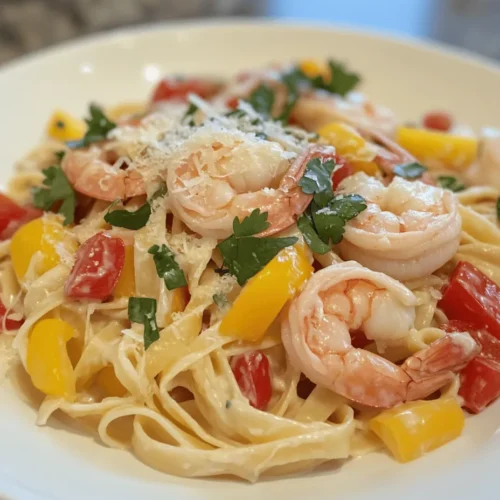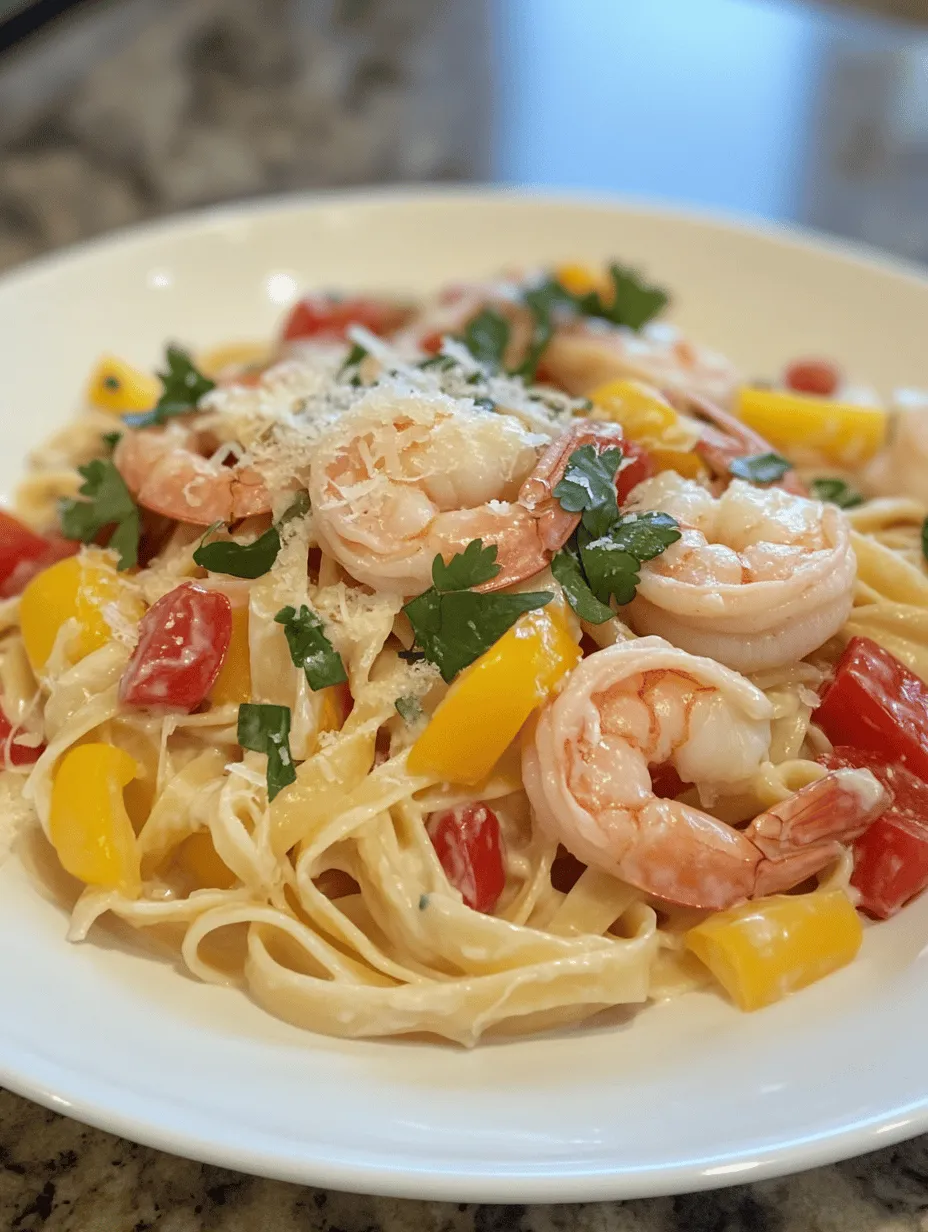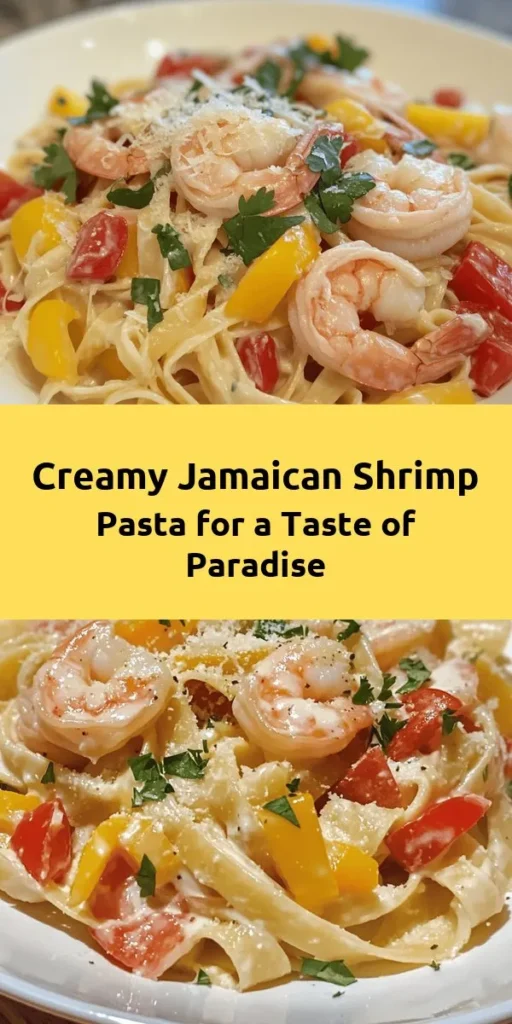Introduction
Jamaican cuisine is a vibrant celebration of flavors, colors, and textures that reflects the island’s rich cultural heritage. From spicy jerk chicken to sweet plantains, every dish tells a story, and among these culinary treasures, Jamaican shrimp pasta stands out as a delightful fusion of traditional ingredients and modern cooking techniques. This Caribbean-inspired dish combines the lush creaminess of a pasta sauce with the bold spices typical of Jamaican cooking, resulting in a meal that is both comforting and exciting.
The appeal of Jamaican shrimp pasta lies not only in its rich taste but also in its versatility. It’s an ideal choice for weeknight dinners when time is of the essence, yet it possesses a level of sophistication that makes it perfect for special occasions. Whether you’re hosting friends or simply enjoying a quiet evening at home, this dish caters to all scenarios with ease. The creamy sauce envelops perfectly cooked shrimp and pasta, creating a dish that is not just a meal but an experience.
Understanding the Ingredients
To create the perfect Jamaican shrimp pasta, understanding the key ingredients is essential. Each component plays a crucial role in building the dish’s unique flavor profile, ensuring that every bite is a harmonious blend of tropical and creamy elements. Below, we delve into the main ingredients that contribute to this delicious recipe.
Fettuccine or Pasta of Choice
At the heart of this dish is pasta, with fettuccine being a popular choice due to its broad, flat shape that holds the sauce beautifully. However, feel free to customize the recipe by using other pasta varieties such as linguine, penne, or even gluten-free options. The type of pasta you select can alter the dish’s texture and presentation, so choose one that you enjoy and that complements the creamy sauce.
Large Shrimp
When it comes to the shrimp, opting for large, succulent shrimp is essential for creating an impressive dish. Fresh shrimp is preferable due to its superior flavor and texture, which can elevate your pasta to restaurant-quality. If fresh shrimp is not available, frozen shrimp can serve as a convenient alternative; just ensure they are properly thawed before cooking. The sweetness of the shrimp balances the dish’s spices and adds a delightful contrast to the creamy sauce.
Olive Oil, Garlic, and Onion
Aromatic ingredients such as olive oil, garlic, and onion form the foundation of flavor in this dish. The olive oil serves as the cooking medium, adding a richness to the dish while enhancing the natural flavors of the ingredients. Garlic and onion are sautéed together to create a fragrant base that infuses the entire dish with depth. Their savory notes are essential for building the overall flavor profile of the pasta.
Bell Pepper, Thyme, and Allspice
To achieve authenticity, we incorporate bell pepper, thyme, and allspice, which are staples in Jamaican cooking. The bell pepper adds a sweet crunch and vibrant color, while thyme contributes a fresh, herbaceous note that complements the shrimp beautifully. Allspice, with its warm and slightly sweet flavor, brings a unique depth to the sauce, making it distinctly Jamaican. Together, these ingredients create a complex flavor that is both comforting and exotic.
Coconut Milk and Heavy Cream
The star of the sauce is the combination of coconut milk and heavy cream. Coconut milk brings a tropical sweetness and a silky texture that enhances the dish’s creaminess, while heavy cream adds richness and body. This dynamic duo creates a luscious sauce that envelops the pasta and shrimp, making each bite a creamy delight. Adjusting the ratios of these ingredients allows you to customize the sauce to your personal taste preferences.
Cherry Tomatoes and Lime Juice
Freshness is key to balancing the richness of the sauce, and this is where cherry tomatoes and lime juice come into play. The burst of flavor from the cherry tomatoes adds a juicy sweetness, while lime juice introduces a bright acidity that cuts through the creaminess. This balance ensures that the dish remains light and refreshing, making it perfect for any occasion.
Garnish Options
Finally, garnishing your Jamaican shrimp pasta elevates both its presentation and flavor. Fresh cilantro adds a burst of color and an herbal note that complements the tropical flavors in the dish. Additionally, a sprinkle of freshly grated Parmesan cheese can intensify the richness of the pasta, creating a delightful contrast with the other flavors. Explore different garnish options to personalize your dish and impress your guests.
Step-by-Step Cooking Process
Creating Jamaican shrimp pasta is a straightforward process that results in a meal bursting with flavor. Below is a detailed breakdown of each cooking step to guide you through the preparation.
Cooking the Pasta
The first step in making Jamaican shrimp pasta is to cook the pasta. Start by bringing a large pot of salted water to a rolling boil. Adding salt to the water is crucial as it enhances the pasta’s flavor during cooking. Once the water is boiling, add fettuccine or your pasta of choice.
It’s important to follow the package instructions for cooking time, aiming for al dente texture. This means the pasta should be cooked through but still firm when bitten. Al dente pasta not only provides the ideal texture but also holds up better when combined with the creamy sauce. Keep an eye on the pasta during cooking; overcooked pasta can become mushy and lose its appealing bite.
Once the pasta reaches the desired doneness, reserve a cup of the pasta water and then drain the rest. This starchy water can be used later to adjust the consistency of the sauce if needed. Set the cooked pasta aside while you prepare the shrimp and sauce.
Sautéing Aromatics
In a large skillet or frying pan, heat olive oil over medium heat. Once the oil is shimmering, add chopped onion and minced garlic. Sauté these aromatics until they become translucent and fragrant, about 2-3 minutes. The goal here is to draw out their natural sweetness and develop a robust base for the sauce.
Adding Shrimp and Vegetables
Next, add the large shrimp to the skillet, cooking them until they turn pink and opaque, which typically takes about 3-4 minutes. Be careful not to overcrowd the pan, as this can lead to steaming instead of sautéing. If necessary, cook the shrimp in batches to ensure they sear nicely.
Once the shrimp is cooked through, toss in sliced bell pepper, fresh thyme, and allspice. Stir everything together, allowing the vegetables to soften slightly while the spices infuse the mixture with their flavors. The vibrant colors of the bell pepper will add visual appeal, making your dish even more enticing.
Creating the Creamy Sauce
Now it’s time to create the creamy sauce. Pour in the coconut milk and heavy cream, stirring to combine. Allow the mixture to simmer gently, letting the flavors merge and the sauce thicken slightly. If the sauce appears too thick, you can add a little reserved pasta water to reach your desired consistency.
Once the sauce is well combined, add halved cherry tomatoes and a squeeze of fresh lime juice. The tomatoes will soften in the heat, releasing their juices into the sauce, while the lime juice will brighten the dish, balancing the richness of the cream and coconut milk.
As the sauce simmers, taste and adjust seasoning as necessary, adding salt and pepper to enhance the flavors further.
Combining Pasta and Sauce
Finally, add the cooked pasta to the skillet, tossing everything together until the pasta is evenly coated with the creamy sauce. This step is crucial for ensuring that every strand of pasta is enveloped in the rich flavors of the sauce. If the mixture seems dry, add more reserved pasta water to loosen it up and achieve the desired creaminess.
You are now just moments away from enjoying a delicious plate of Jamaican shrimp pasta!
In this first part of the recipe article, we’ve explored the vibrant essence of Jamaican cuisine, the key ingredients that create a creamy and flavorful dish, and the initial steps to begin your cooking journey. Stay tuned for the next part, where we will delve deeper into the finishing touches and presentation of this delectable meal.

Sautéing Aromatics
To achieve a perfectly sautéed base for your Jamaican Shrimp Pasta, it’s essential to understand the techniques that will enhance the overall flavor of the dish. Begin by heating your olive oil or butter in a large skillet over medium heat. The oil should shimmer but not smoke; this indicates that it’s hot enough to start cooking the aromatics.
1. Choosing Aromatics: For this dish, garlic, onion, and bell peppers are ideal. Dice them finely to ensure even cooking. You can also include fresh herbs like thyme or scallions for added depth.
2. Sautéing Technique: Add the onions first, as they take longer to soften. Sauté them for 2-3 minutes until they become translucent, then add the garlic and bell peppers. Stir frequently to prevent burning and to allow the flavors to meld. The goal is to achieve a fragrant, flavorful base without browning the ingredients excessively.
3. Flavor Development: When sautéing, don’t rush the process. Allowing the aromatics to cook slowly will release their natural sugars, enhancing the overall taste of your dish. As they cook, a delightful aroma will fill your kitchen, hinting at the delicious meal to come.
Cooking Shrimp
Cooking shrimp to perfection is key to this recipe. Follow these best practices to ensure they are juicy and full of flavor:
1. Preparation: If you haven’t already, peel and devein the shrimp, leaving the tails on for presentation if desired. Rinse them under cold water and pat them dry with paper towels. This step is crucial as excess moisture can prevent proper sautéing.
2. Seasoning: Before cooking, season the shrimp lightly with salt, pepper, and a dash of paprika or cayenne for a hint of heat. The seasoning will enhance the natural sweetness of the shrimp.
3. Cooking Technique: Increase the heat to medium-high and add the shrimp to the skillet. Sauté them quickly for about 2-3 minutes on each side, or until they turn pink and opaque. Overcooking shrimp can lead to a rubbery texture, so keep a close eye on them. Once cooked, remove the shrimp from the skillet and set them aside to prevent continuing to cook in residual heat.
Making the Sauce
The creamy sauce is what takes this dish to the next level. Here’s how to achieve the desired consistency and flavor balance:
1. Base Ingredients: Start with coconut milk as the main component. Not only does it provide creaminess, but it also infuses the dish with a subtle sweetness that perfectly complements the spices.
2. Building Flavors: After removing the shrimp, lower the heat and add the coconut milk to the same skillet. Scrape any bits stuck to the bottom, as these add flavor. Incorporate additional seasonings like jerk seasoning, lime juice, and fresh herbs at this stage to create a well-rounded sauce.
3. Consistency: Allow the sauce to simmer gently for about 5-7 minutes, stirring occasionally. This will thicken the sauce slightly. If it becomes too thick, you can add a splash of pasta water or broth to loosen it—this technique also helps to marry the flavors together.
4. Final Touches: Before combining with the pasta, taste the sauce and adjust the seasoning, adding more salt, pepper, or lime juice as needed. The balance of flavors is crucial, as the sauce should be rich but not overpowering.
Combining Pasta, Shrimp, and Sauce
Now that you have your pasta, shrimp, and sauce ready, it’s time to combine them into a cohesive dish:
1. Cooking the Pasta: Make sure your pasta is cooked al dente according to package instructions. Reserve a cup of pasta water before draining. This starchy water can help adjust the sauce’s thickness later.
2. Mixing Technique: In the skillet with the sauce, add the drained pasta, followed by the cooked shrimp. Gently toss everything together using tongs or a large fork. Avoid breaking the pasta by being gentle during this step.
3. Adjusting Consistency: If the sauce appears too thick, add a splash of reserved pasta water to help everything blend seamlessly. The starchy water not only helps in achieving the right consistency but also helps the sauce cling better to the pasta.
4. Finishing Touches: Stir in freshly chopped herbs like parsley or cilantro for a burst of freshness just before serving. This not only adds color but also enhances the aromatic experience of the dish.
Flavor Profiles and Culinary Techniques
Exploring the flavor profiles in Jamaican cuisine reveals a rich tapestry of tastes that make dishes vibrant and exciting. The combination of spices such as allspice, thyme, and scotch bonnet peppers lends depth and warmth to the dish. The creamy coconut milk balances the heat from the spices while enhancing the natural sweetness of the shrimp.
Understanding the culinary techniques used in this recipe is vital:
– Sautéing: This method not only develops flavors through caramelization but also provides a foundation for the dish.
– Simmering: Slow cooking the sauce allows the flavors to meld, creating a harmonious blend that is both comforting and indulgent.
– Tossing: Properly combining the pasta and sauce ensures that every bite is flavorful, with the sauce enveloping the pasta rather than pooling at the bottom of the plate.
Serving Suggestions and Pairings
Jamaican Shrimp Pasta is a delightful main dish that can be complemented with various sides and beverages:
1. Side Dishes: A fresh salad with mixed greens, avocado, and a light citrus vinaigrette pairs beautifully with this dish, providing a refreshing contrast. Alternatively, garlic bread or a crusty baguette can be served to soak up the creamy sauce.
2. Beverage Pairings: For a tropical experience, consider pairing your meal with a fruity cocktail such as a piña colada or a refreshing mojito. If you prefer non-alcoholic options, a coconut water or a chilled ginger beer can enhance the meal’s flavors.
Nutritional Information
This Jamaican Shrimp Pasta not only excites the taste buds but also offers nutritional benefits:
– Lean Protein: Shrimp is an excellent source of lean protein, low in calories but high in essential amino acids that are vital for muscle health and overall well-being.
– Healthy Fats: The use of coconut milk introduces healthy fats, which are beneficial for heart health and can contribute to improved cholesterol levels.
– Vegetable Content: Including bell peppers and onions provides fiber, vitamins, and minerals that enhance the nutritional profile of the dish.
As with all indulgent recipes, it’s about balance. Enjoying this dish as part of a well-rounded diet, including plenty of fruits, vegetables, and whole grains, ensures you reap the health benefits without compromising on flavor.
Conclusion
Jamaican Shrimp Pasta is a unique and flavorful dish that brings the essence of Caribbean cuisine to your table. Its creamy sauce, perfectly cooked shrimp, and aromatic spices create a delightful culinary experience that is easy to replicate at home. This recipe not only celebrates the vibrant flavors of Jamaica but also provides a comforting meal that can be enjoyed on any occasion.
We encourage you to try this recipe for yourself. Whether you’re looking to impress guests at a dinner party or simply craving a taste of the tropics, this dish is sure to satisfy. Embrace the rich flavors and culinary techniques of Jamaican cuisine, and let your taste buds embark on a delicious journey.



